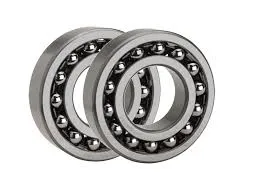
dec . 09, 2024 18:14 Back to list
Comparing Spherical Roller Bearings and Ball Bearings for Optimal Performance and Durability
Spherical Roller Bearings vs. Ball Bearings A Comprehensive Comparison
When it comes to choosing the right bearing for a specific application, the decision often narrows down to two popular types spherical roller bearings and ball bearings. Each type has its unique characteristics, advantages, and disadvantages, making them suitable for different operational requirements. This article aims to explore the key differences between these two types of bearings, helping engineers and purchasing managers make informed decisions.
Structure and Design
Spherical roller bearings consist of two rows of rolling elements (typically uniform, barrel-shaped rollers) that can accommodate axial and radial loads simultaneously. Their design allows for a certain degree of misalignment, making them ideal for applications where shaft misalignment might occur. The inner and outer raceways are designed to follow a spherical shape, granting these bearings the capability to handle bearing loads in multi-directional positions.
In contrast, ball bearings are designed with steel balls as the rolling elements. They are typically used in applications that require high-speed rotations. While ball bearings can handle both radial and axial loads, their capacity to accommodate misalignment is limited. This makes ball bearings suitable for applications where precision and low friction are critical, such as electric motors and spindles.
Load Capacity
When it comes to load capacity, spherical roller bearings often outperform ball bearings. This is primarily due to the larger contact area between the roller elements and the raceways. As a result, spherical roller bearings can handle heavier radial loads and some axial loads, making them suitable for heavy machinery and industrial applications. In contrast, ball bearings are typically better for applications with lighter loads and higher speed requirements, as their design minimizes rolling resistance.
Speed Capability
spherical roller bearing vs ball bearing

Ball bearings generally excel in high-speed applications due to their lower friction and lighter weight compared to spherical roller bearings. They can efficiently handle greater rotational speeds, making them ideal for applications like electric motors, fans, and high-speed valves. Spherical roller bearings, while capable of operating at moderate speeds, are not as efficient in high-speed applications because of the additional friction generated by their rolling elements.
Misalignment Tolerance
One of the significant advantages of spherical roller bearings is their ability to tolerate misalignment. This is particularly beneficial in applications where precise alignment is challenging, such as in heavy machinery, conveyor systems, and large-scale industrial drives. The self-aligning feature reduces the stresses on the bearings, extending their lifespan. Ball bearings, in contrast, demand a more precise alignment to operate efficiently, making them less suitable for conditions where misalignment is a possibility.
Maintenance and Durability
Both spherical roller bearings and ball bearings require proper maintenance to ensure longevity, but their durability can vary depending on the application and environment. Spherical roller bearings are usually more robust and can withstand harsher operating conditions encountered in industries like mining and construction. However, ball bearings can be engineered for specific applications, with features such as seals and shields to enhance their resistance to dust and moisture.
Conclusion
In summary, the choice between spherical roller bearings and ball bearings rests heavily on the specific needs of the application. If the machinery involves heavy loads, potential misalignment, and moderate speeds, spherical roller bearings are likely the better option. However, for high-speed, high-precision applications with lighter loads, ball bearings will often deliver superior performance. Understanding these differences not only aids in selecting the right bearing but can also impact the overall efficiency and reliability of the machinery in which they are used.
Latest news
-
Durable Greenhouse Pillow Block Bearings for Reliable Ventilation
NewsAug.31,2025
-
Spherical Roller Bearings Applications: Heavy Duty, Self-Aligning
NewsAug.30,2025
-
Premium Deep Groove Ball Bearings | High Speed & Reliability
NewsAug.29,2025
-
Durable Scaffolding Clamps - Secure & Reliable Tube Connectors
NewsAug.28,2025
-
Common Failures in Thrust Ball Bearings and Solutions
NewsAug.22,2025
-
How Tapered Roller Bearings Can Take Shock Loads
NewsAug.22,2025
